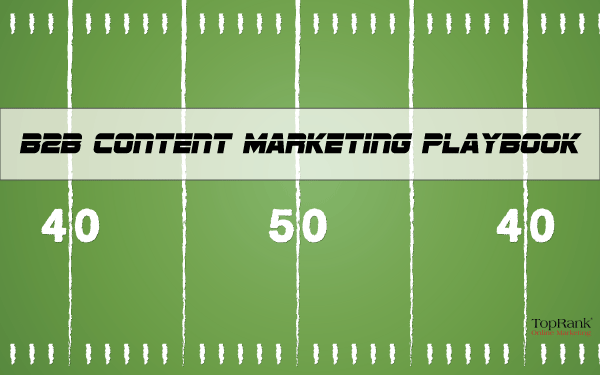
The 2015 B2B Marketing Report from Content Marketing Institute and MarketingProfs sheds a pretty bright light on the true state of B2B content marketing. While 86% of B2B marketers are using content marketing, only 8% rate their content marketing efforts as “very effective”. It’s not so different than teams participating in sports like football. Sure, everyone is playing, but who is actually really good at it?
Fundamental blocking and tackling are key for a winning football game. The same can be said for implementing a successful B2B content marketing program: mastery of the fundamentals is essential. With B2B content creation in particular, marketers must be prepared for everything from understanding the voice of the customer to developing the right mix of content assets.
For most B2B marketers, staying on top of the B2B content marketing game takes practice, practice and more practice to be successful. Drilling those basic skills can mean the difference between winning and losing the business customer acquisition game.
Here’s the good news: We’ve put this B2B Content Marketing Playbook together to provide you with all the content marketing formations you’ll need to play the B2B content game right and maybe even win a content marketing championship!

Learn the Language of Your Customer
Writing killer content for business buyers takes practice. Part of that practice involves understanding the language of the industry that you’re writing for. It is important to strike a balance between incorporating the proper industry terms while not overstuffing your content or using jargon in the wrong context.
Here are a few steps you can take to catch on to the terms you need to know:
- Talk to your current customers – learn their pain points, goals and the words they use to describe what’s important
- Review the website content of your customers and their competitors – learn to speak like a native
- Search for and absorb information from reputable content sources online – where do your customers discover and consume industry and solutions information? What publications, influencers and peers do they listen to and read?
Connect with the Right Content Marketing Resources
Believe it or not, sometimes you’ll need to bring in reinforcements. Determining whether you need to hire experienced industry copywriters for the short or long-term, depends on the project.
No matter how long contract copywriters or content marketing agency resources are a part of your marketing team’s efforts, learn as much as you can in the time that you’re working with them. Be wary of writers that claim to have industry expertise but don’t provide examples of their work.
When interviewing potential resources, keep the following in mind:
- How long have they been creating content for the specific industry?
- Have they written content for a reputable content source or company?
- What is their process for understanding content goals, customer voice and actual content creation?
Map B2B Buyer Personas to Content
To deliver the most relevant and useful information to B2B buyers, its important to identify distinct customer segments and the stages of their buying experience. To write specifically for a group of buyers and what they care about, it’s useful to create a persona that represents their common interests, behaviors, pain points and goals.
For each persona and buying experience or journey, customers will have different types of questions depending on where they are in the process. The B2B content you create should address the needs of a specific customer persona as well as the broad to specific questions they need answered when investigating the kinds of solutions your company offers.
Let’s assume for a second that the product is a marketing automation tool and the target customer is a large brand seeking a solution to help deliver their marketing in a more structured and meaningful way. It’s important that content is created for any one of the positions/needs below:
- Director of Marketing: Is interested in seeing if there is a better way to create, distribute and track content.
- Stage: Awareness
- Sample Blog Content: 10 Signs You May Need Marketing Automation
- Marketing Manager: Has been given a directive to create a cost/capability comparison for a variety of different marketing automation solutions:
- Stage: Engagement
- Sample Blog Content: 5 Features & Benefits of XYZ Marketing Automation
- VP of Marketing: Needs to determine if Marketing Automation will be a sound investment for the organization.
- Stage: Conversion
- Sample Blog Content: 7 Ways Marketing Automation Saves Money & Improves Efficiency
The examples above only scratch the surface in terms of potential personas, stages in the buying cycle and types of content that can be used to meet the needs of your customers.

Lead Your Content with Key Points
It’s likely that the professionals searching for B2B solutions have responsibilities outside of purchasing the product that you’re promoting via content marketing (aka, they’re busy). Keep that in mind when you’re determining how to structure content.
Blog posts for example, should quickly summarize key points so that the reader can decide if they would like to continue reading. This sets the stage for what they’ll find in the blog post.
The B2B and H2H Tug of War
B2B customers desire content that meets both their personal and business needs. How can you strike that delicate balance?
- Be specific
- Show empathy
- Focus on solutions
- Inject voice and personality
- Create content for where they live (social, mobile), not just where they work (blogs, publications)

Incorporate Multiple Types of Content
Did you know that there are well over 30 types of Content Marketing tactics? Based on the product or service that content is being created for, and the audience, there is an incredible opportunity to provide multiple content types to provide buyers with the best possible information experience. Examples of tactics that have traditionally worked well for B2B marketing include:
- Case Studies
- White Papers
- Blog Posts
- eBooks
- Digital Newsletters
- Email Marketing
- Webinars and Real World Events
Also consider the “human” side of B2B marketing through social media, mobile and visually-focused content. After all, buyers are people too.
Include Calls to Action (CTAs)
B2B content should almost always include a call to action of some sort. It’s important that you always give readers direction on what to do next, whether it’s to consume another piece of content, subscribe, share or make an appointment. Here are some things to keep in mind when considering B2B content CTAs:
- Don’t Be Shy: Your CTAs should stand out as a clear next step. Instead of burying your CTA at the bottom of the page, consider using your content header or sidebar.
- Keep it Simple: While you may want to know everything about the person completing your CTA, you have to remove the barrier to entry. Ask for only the necessary information you need to accomplish your goal.
- Offer Value, Again: Remind the prospect what they’re signing up for. Be sure to reiterate that they are signing up for XYZ webinar, which will help them accomplish ABC.
Experiment with Landing Pages
Landing pages create an enormous opportunity for capturing information that can be used to effectively nurture B2B leads. When experimenting with landing pages here are a few tips to keep in mind:
- There may be different levels of decision makers and different stages of the buying cycle.
- You can increase the value of good content by requiring form completion
- Take some time to A/B test your page content and forms
- Always include testimonials
Why Mastering the Game of B2B Content Marketing is Essential
Jumping head-first into a game of B2B content marketing without mastering the blocking and tackling basics can quickly have you experiencing more losses than wins. In order to create successful B2B content, understand who your customers are, what they care about and how the product that you’re marketing helps solve their business problem. Speak to your target buyer using their language, using the kinds of content they prefer and with offers that will be the most compelling for them to take action.
In football, it’s often said that the best defense is a good offense. Stay on top of your B2B content marketing game by incorporating the basic rules from this B2B Content Marketing Playbook into your content routine.


